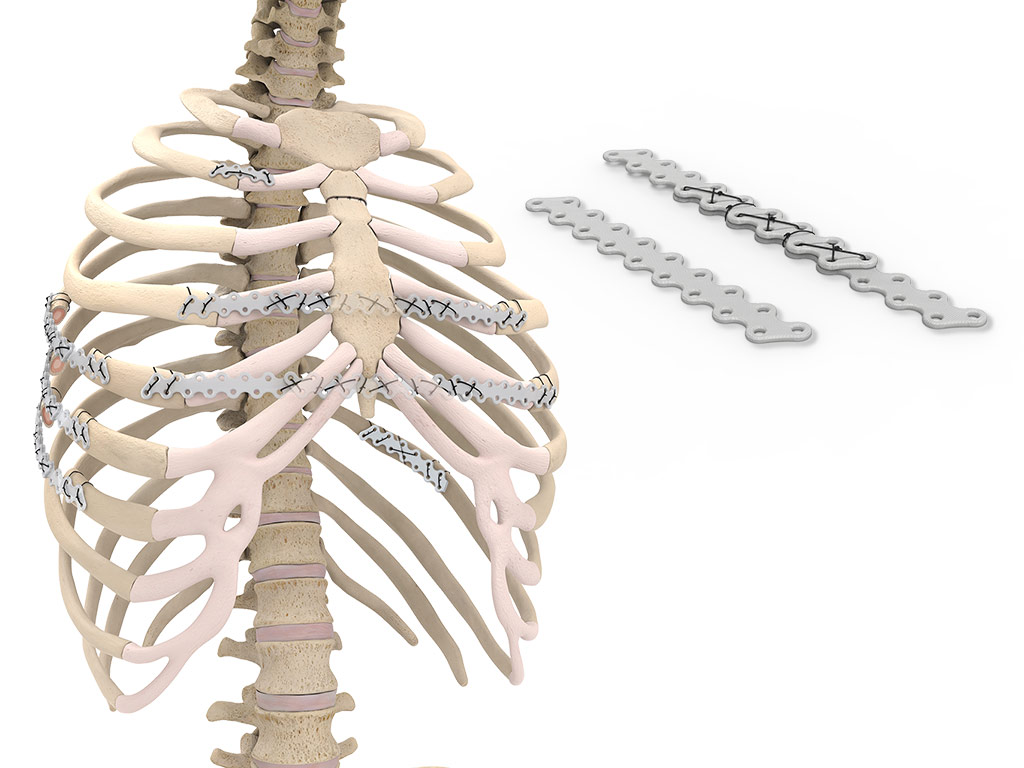
BioBridge
December 10, 2020
Product Overview Acute Innovations BioBridge Resorbable Chest Wall Stabilization Plate is a versatile, nonpermanent solution for chest wall stabilization. It was specifically designed to offer strength that exceeds typical chest wall loading1 and a resorption time that outlasts typical bone healing time.1 Indications for Use In the presence of appropriate additional immobilization or fixation, indicated for maintaining the alignment and …
Product Overview
Acute Innovations BioBridge Resorbable Chest Wall Stabilization Plate is a versatile, nonpermanent solution for chest wall stabilization. It was specifically designed to offer strength that exceeds typical chest wall loading1 and a resorption time that outlasts typical bone healing time.1
Indications for Use
In the presence of appropriate additional immobilization or fixation, indicated for maintaining the alignment and fixation of bone fractures, osteotomies, arthrodeses or bone grafts, maintenance of relative position of weak bony tissue (e.g., bone grafts, bone graft substitutes, or bone fragments from comminuted fractures), as well as trauma and reconstructive procedures. Specifically, BioBridge can also be used on metacarpus, proximal and middle phalangeal bones, as well as long bones, flat bones, short bones, irregular bones, appendicular skeleton, and thorax.
Features and Benefits
- Packaging: Sterile and single-packed
- Dimensions: 110 mm x 14 mm x 1.8 mm
- Composition: 70:30 L/DL-lactide blend
- Durability: Maintains strength and stability for up to six months1
- Resorption Profile: Fully resorbed within 18-24 months through hydrolysis1
- Handling Characterists: Textured for easy handling and visibility
- Flexibility: Can be cut or molded to match the rib curvature
- Stackable: Plates can be stacked for increased rigidity and/or length
Applications and Techniques
- Costochondral Junction Repair: Fractured cartilage caused by trauma or during a thoracotomy can be challenging to repair and require extended healing time. BioBridge can be used to stabilize the fracture through reduction and compression.
- Pectus Repair: During a modified Ravitch procedure, BioBridge can be used as a nonpermanent strut instead of using suture alone. This technique provides added support to the elevated sternum, with the goal of reducing recurrence of the pectus deformity. The document BioBridge Open Pectus Repair Surgical Technique provides precise information about this technique.
- Chest Wall Reconstruction: Reconstruction may be indicated due to chest wall tumors (benign and malignant), radiation necrosis, contiguous lung or breast cancer and lung/chest wall infections2,3 and trauma. The reconstruction technique, as described in BioBridge Chest Wall Reconstruction Surgical Technique provides long-term chest wall stability through bone healing and/or soft tissue scarring.
- Osteotomy Stabilization: An osteotomy or iatrogenic fracture of the ribs during thoracotomy has been associated with post thoracotomy pain4,5. BioBridge is ideal for internal stabilization of these types of fractures if a nonpermanent solution is desired.
Citations
- Data on file at Acute Innovations.
- Downey RJ, Rusch V, Hsu FI, Leon L, Venkatraman E, Linehan D, Bains M, van Zee K, Korst R, Ginsberg R. Chest wall resection for locally recurrent breast cancer: is it worthwhile? J Thorac Cardiovasc Surg. 2000 Mar; 119(3): 420-8.
- Martini N, Huvos AG, Burt ME, Heelan RT, Bains MS, McCormack PM, Rusch VW, Weber M, Downey RJ, Ginsberg RJ. Predictors of survival in malignant tumors of the sternum. J Thorac Cardiovasc Surg. 1996 Jan; 111(1): 96-105; discussion 105-6.
- Alex G. Little, MD, Walter H. Merrill, MD. 2011. Complications in Cardiothoracic Surgery: Avoidance and Treatment.
- Karmakar MK, Ho AM. Postthoracotomy pain syndrome. Thorac Surg Clin. 2004 Aug; 14(3):345-52